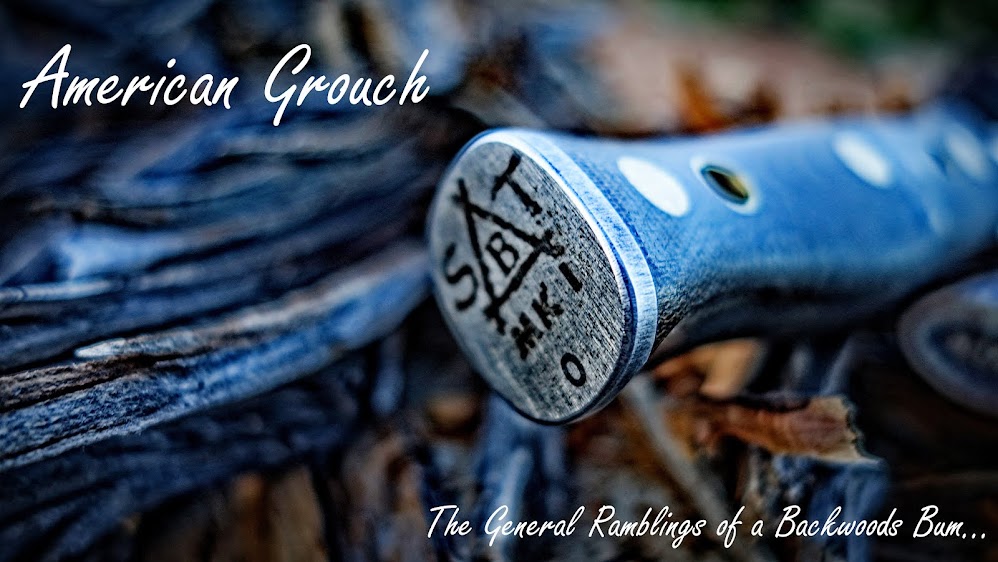No need for words.
11 October 2010
Latest obsession, sort of.
I've become intrigued with utensil carving, how odd is that?
I've seen some of the carvings done and I am blown away at the detail and skill. Most of these are done with a small bushcraft knife and a hook knife. Well I have not gotten my hook knife yet, I'm ordering one this week, for the time being I decided to give this a shot with a basic old Hudson Bay styled butcher knife. The results are not exactly works of art, but for twenty minutes and an old butcher knife it isn't so bad.
I had a good time doing it and I'm certainly looking forward to mastering the skill needed to produce much better specimens. Started with a large chunk of Birch wood.
Splitting that down with a bit of light baton work I had the following two pieces to work with.
From there, about twenty minutes and a lot of chips flying I ended with this. Still need to do some sanding and fine work. Serviceable as they are.
I've seen some of the carvings done and I am blown away at the detail and skill. Most of these are done with a small bushcraft knife and a hook knife. Well I have not gotten my hook knife yet, I'm ordering one this week, for the time being I decided to give this a shot with a basic old Hudson Bay styled butcher knife. The results are not exactly works of art, but for twenty minutes and an old butcher knife it isn't so bad.
I had a good time doing it and I'm certainly looking forward to mastering the skill needed to produce much better specimens. Started with a large chunk of Birch wood.
Splitting that down with a bit of light baton work I had the following two pieces to work with.
From there, about twenty minutes and a lot of chips flying I ended with this. Still need to do some sanding and fine work. Serviceable as they are.
08 October 2010
Fire- Cattails & Jute Twine
I've seen this method before, wanted to show how I do it and a slight twist to the usual recommendation.
You'll need some simple ingredients to get started.
1. Paraffin wax
2. Jute twine (I use the small stuff but many suggest the bigger twine)
3. Pot to melt the wax in
4. Knife
5. Fire
Word of caution, once melted the wax is quite flammable, your wife, if you use one of her pots, is also flammable.
If you use a camp fire, use caution as the heat level is not as easy to regulate as your stove top. I like doing it outside so I used a small fire.
Once I've got the fire going and waiting for it to burn in a bit I cut the twine, 8 to 12" in length.
With the fire about right I'll put my melting pot on with a couple blocks of wax.
Once the wax is melted I'll lay in the twine, I do not suggest putting a whole bundle in at a time.
Once they've been in a bit I'll pull them with a stick and lay them to cool.
Here is where things start to differ compared to what most recommend. Where I live, if I NEED a fire as in right now, I need it right now. I don't have the time or luxury of nimble fingers to pick and peel the jute apart to make it fibrous enough to take a spark from a firesteel. It would be winter, between -20 to -30 with howling winds, snow or freezing rain. In those conditions a man's fingers are not nearly as dexterous as in normal conditions. Fingers get stiff, don't want to move, hard enough to grasp the firesteel and striker. Something I usually do with mits on for that very reason, pulling jute twine into a fibrous nest with mitts on is impossible. (One of the other reasons my firesteel is large, built into a deer bone and easy to grasp, even with mitts.)
With that in mind, I like to twist or roll the waxed twine into lumps, or balls or squares as seen here:
Then I'll mix these up with old cattail fluff. It'll stick to the waxy jute. Further if you pull the jut a bit and get good gobs of the cattail fluff mixed together you can squeeze it back into a compact unit. The cattail fluff is very easy to ignite but it burns extremely fast. If you are using it in conjunction with waxed jute though it fires the jute which will burn a nice long time. Basically, your using the easy ignition point of the cattail to get the twine going. Most of what I have seen others recommend is pulling the jute apart to make your tender bundle. I like to use cattail fluff with the twine as it works much better for a fire right now situation.
If you've got it right, it'll look like this, as with all of my fires I really try to build them on a layer of birch bark. It's prolific here and a very nice fuel.
It'll take a spark very easily and spread to flame as well with little extra effort.
Incidentally, I used the left over melted wax to reseal my leather tinder bag. A pretty nice leather piece my daughter made for me.
The waxed jute twine and cattail fluff, travels light and easy and in good quantities.
Here's what the inside looks like, cattail fluff, jute twin, cedar and pine shavings also in there as well as a couple pieces of fatwood in the bottom.
Subscribe to:
Posts (Atom)






















